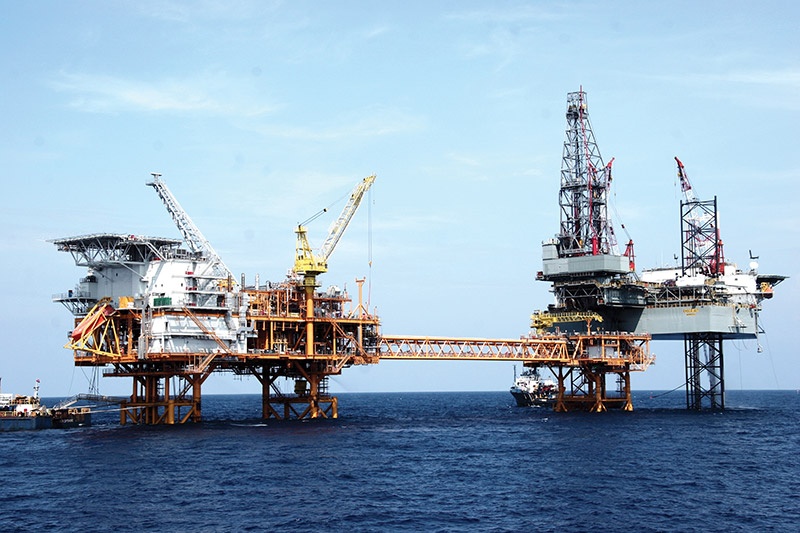Uncertainty lingers on with global oil and gas investment
 |
| Uncertainty lingers on with global oil and gas investment |
Vietnam Oil and Gas Group (PetroVietnam) may soon deal with issues that lasted since the second quarter of 2020 with Murphy Oil, an American energy corporation, and the Golden Camel project in the Cuu Long basin about 120km from the shore.
On May 13, Roger Jenkins, general director of Murphy Oil, met with Vietnamese Prime Minister Pham Minh Chinh and discussed how to accelerate the progress of the Golden Camel project.
Last November, after adjusting for reserves, the Field Development Report prepared by Murphy Oil was approved by PetroVietnam Exploration and Production Corporation (PVEP), but the Ministry of Industry and Trade and PetroVietnam had not yet approved it due to a disagreement.
In Vietnam, Murphy Oil has invested about $300 million in the search and exploitation of oil and gas blocks in the Cuu Long and Phu Khanh basins. The Golden Camel project, in which Murphy Oil is also involved, has a total investment of $700 million.
Global oil prices continued to remain high, prompting oil and gas companies to return to exploitation and exploration. PVEP announced on May 27 that it had put 43 oil and gas fields and projects into operation, bringing the total output to 72 million tonnes of oil equivalent.
The exploitation of fields discovered in the previous stage, and the sale of oil at high prices, help the oil and gas sector continue to maintain its leading position, along with significant payment to the state budget.
PetroVietnam’s contribution accounted for about 7.7 per cent of the total state budget revenue in the first quarter of 2022. According to the state budget estimate submitted to the National Assembly by the government, the estimated revenue from crude oil is about $1.2 billion, accounting for 2 per cent of the total state budget balance. This estimate is based on the domestic production of nearly seven million tonnes, with an oil price of $60 per barrel.
Compared with the revenue from crude oil in 2011 of about $1.5 billion and an exploitation level of 8.48 million tonnes with an oil price of $62 per barrel, the 2022 plan has nearly 1.5 million tonnes of extracted oil less and the budget revenue also shrunk by about $300 million.
PetroVietnam’s data showed that most oil and gas fields were put into operation between 1986 and 2015. There are fields that have been in production for 15-35 years and those that are in the final life stage, leading to a natural decline in production at these mines of about 15-25 per cent per year.
Oil and gas analysts believe that the lack of operating mechanisms and investment capital for search and exploration is the main reason leading to the decline in output.
Doan Van Thuan from the Vietnam Petroleum Institute said, “Operating in deep water areas far from the shore is difficult, so the risks are very high. Globally, the success probability of offshore exploration wells is only about 10-20 per cent on average. Thus, Vietnam must invest in search and exploration to be able to increase its reserves in the future.”
Compared with the contribution to the state’s budget, the country’s investment in technology research for the oil and gas mines remains very modest. The Centre for Applications of Nuclear Technique in Industry (CANTI) under the Ministry of Science and Technology started research on marking oil in gas fields under exploitation in 1999.
However, CANTI chairman Nguyen Huu Quang said, “It was not until 2015 that the world made new strides in oil marking thanks to the use of simulation technology. However, that technology was very costly, up to $500,000 per well. We think there should be new ways to get more information, at a lower cost, and with a better mass application.”
CANTI has built on the results of previous research by the University of Houston, which used natural indicators drifting from the field to assess the amount of oil remaining in a field and area.
What the stars mean:
★ Poor ★ ★ Promising ★★★ Good ★★★★ Very good ★★★★★ Exceptional
Related Contents
Latest News
More News
- Driving double-digit growth through green and circular transformation in Vietnam (December 17, 2025 | 09:00)
- Standard Chartered and ACCA deepen collaboration to develop Vietnam’s talent for a sustainable future (December 15, 2025 | 18:18)
- Schaeffler reports strong early output from Dong Nai solar project (December 12, 2025 | 15:16)
- Forestry conference highlights biodiversity and sustainability goals (December 09, 2025 | 13:35)
- Home Credit honoured among top 10 sustainable companies in trade and services (December 09, 2025 | 12:18)
- SCG and seven member companies honoured in Top 100 Sustainable Businesses 2025 (December 08, 2025 | 09:00)
- Nestlé Vietnam pioneers sustainable development and promotes business connections (December 06, 2025 | 12:09)
- CSI 2025 highlights rise of Vietnam’s green champions (December 06, 2025 | 09:00)
- Acecook Vietnam named among top 100 sustainable businesses (December 06, 2025 | 08:00)
- Vietnam’s forest carbon credits draw global interest (December 05, 2025 | 17:41)

 Tag:
Tag:





















 Mobile Version
Mobile Version